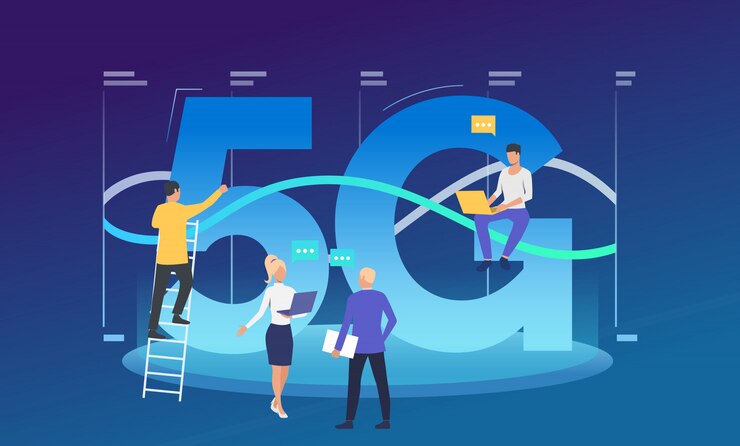
What is 5G Technology?
5G, or the fifth generation of mobile network technology, represents a significant advancement from its predecessors (4G, 3G, and 2G). Designed to meet the growing demands for faster data speeds, lower latency, and more reliable connectivity, 5G technology is poised to transform various sectors, including telecommunications, healthcare, transportation, and entertainment.
Key Features of 5G Technology
- Faster Speeds One of the most notable improvements with 5G technology is its capability to deliver significantly faster data speeds compared to previous generations.
- Enhanced Data Rates: 5G networks can provide download speeds up to 10 Gbps, which is approximately 100 times faster than 4G LTE. This enables rapid data transfer, smooth video streaming in ultra-high definition (UHD), and efficient handling of large files.
- Improved Network Capacity: The increased bandwidth of 5G supports higher data throughput, accommodating more users and devices simultaneously without degradation in performance.
- Lower Latency Latency refers to the delay before a transfer of data begins following an instruction. 5G technology drastically reduces latency, enhancing real-time communication and responsiveness.
- Reduced Response Time: 5G networks can achieve latency as low as 1 millisecond, compared to around 30 milliseconds for 4G. This low latency is crucial for applications requiring instant feedback, such as online gaming, virtual reality (VR), and autonomous vehicles.
- Improved User Experience: The reduced delay enhances user experiences in activities like video conferencing and interactive applications, where immediate response is essential.
- More Reliable Connections 5G technology aims to provide more reliable and consistent connections, even in densely populated areas or challenging environments.
- Enhanced Network Reliability: 5G employs advanced technologies, such as beamforming and massive MIMO (Multiple Input Multiple Output), to direct and improve signal strength and quality, ensuring stable connections.
- Greater Coverage: The deployment of 5G networks includes both low-band, mid-band, and high-band spectrum, offering broad coverage and consistent performance across urban and rural areas.
Applications and Benefits of 5G Technology
- Enhanced Mobile Broadband 5G’s faster speeds and higher capacity enable enhanced mobile broadband experiences, including:
- High-Definition Streaming: Users can stream 4K and 8K video content seamlessly, without buffering or interruptions.
- Augmented Reality (AR) and Virtual Reality (VR): The high data rates and low latency of 5G enable immersive AR and VR experiences for gaming, training, and entertainment.
- Internet of Things (IoT) 5G technology supports the growing network of connected devices, known as the Internet of Things (IoT), by providing:
- Massive Device Connectivity: 5G can support up to 1 million devices per square kilometer, facilitating the connection of a wide range of IoT devices, such as smart home appliances, wearable tech, and industrial sensors.
- Enhanced Automation: The reliable and low-latency connectivity of 5G enables advanced automation and real-time data exchange in smart cities, manufacturing, and agriculture.
- Autonomous Vehicles 5G technology plays a crucial role in the development and deployment of autonomous vehicles by:
- Real-Time Communication: Enabling vehicles to communicate with each other and with infrastructure in real-time, enhancing safety and coordination.
- Advanced Driver Assistance Systems (ADAS): Supporting advanced features such as collision avoidance, adaptive cruise control, and traffic management through reliable and fast data transmission.
- Healthcare The healthcare sector benefits from 5G through:
- Telemedicine: Improving remote consultations and diagnostics with high-quality video and low latency, enabling doctors to interact with patients effectively.
- Remote Monitoring: Supporting real-time monitoring of patients’ vital signs and health data through connected medical devices and wearables.
- Smart Cities 5G technology contributes to the development of smart cities by:
- Efficient Urban Management: Enabling smart grids, traffic management systems, and environmental monitoring to optimize city operations and improve quality of life.
- Public Safety: Enhancing public safety with advanced surveillance systems, emergency response coordination, and real-time information dissemination.
Challenges and Considerations

- Infrastructure Deployment The rollout of 5G networks requires significant investment in new infrastructure, including cell towers and base stations. The deployment of high-frequency millimeter-wave bands also requires denser network coverage.
- Cost and Investment: The high cost of infrastructure development and deployment can be a barrier for network operators and service providers.
- Regulatory Approval: Obtaining regulatory approvals and permits for new infrastructure can be time-consuming and complex.
- Spectrum Availability 5G technology relies on access to a range of spectrum bands, including low, mid, and high frequencies. Ensuring adequate spectrum availability and managing spectrum allocation is essential for network performance.
- Spectrum Auctions: Governments and regulatory bodies must conduct spectrum auctions and allocate frequencies to operators to ensure efficient use of available spectrum.
- Interference Management: Managing interference between different spectrum bands and ensuring optimal performance is crucial for maintaining network quality.
- Security and Privacy As 5G technology enables new applications and connected devices, addressing security and privacy concerns becomes increasingly important.
- Data Protection: Implementing robust security measures to protect user data and prevent cyberattacks is essential for maintaining trust in 5G networks.
- Network Security: Ensuring the security of 5G infrastructure and preventing unauthorized access to network components and data.
- Health and Environmental Impact The potential health and environmental impact of 5G technology is a topic of ongoing research and debate.
- Electromagnetic Radiation: Addressing concerns related to electromagnetic radiation exposure from 5G networks and ensuring compliance with safety guidelines and standards.
- Environmental Considerations: Evaluating the environmental impact of deploying and maintaining 5G infrastructure, including energy consumption and resource use.
Conclusion
5G technology represents a major leap forward in mobile network capabilities, offering faster speeds, lower latency, and more reliable connections. The benefits of 5G extend across various sectors, including enhanced mobile broadband, IoT connectivity, autonomous vehicles, healthcare, and smart cities. While the deployment of 5G presents challenges such as infrastructure investment, spectrum availability, and security concerns, the potential advantages make it a transformative technology for the future. As 5G networks continue to expand and evolve, they will play a pivotal role in shaping the next generation of digital experiences and technological advancements.
[…] 5G Technology Faster Speeds, Lower Latency, and More Reliable Connections […]
[…] 5G Technology Faster Speeds, Lower Latency, and More Reliable Connections […]
[…] 5G Technology Faster Speeds, Lower Latency, and More Reliable Connections […]
[…] Data Analytics Challenges and […]
[…] Investors: Many retail investors are drawn to cryptocurrencies due to their potential for high returns. The accessibility and ease of trading on various […]
[…] 5G Technology Faster Speeds, Lower Latency, and More Reliable Connections […]
[…] 5G Technology Faster Speeds, Lower Latency, and More Reliable Connections […]
[…] 5G Technology Faster Speeds, Lower Latency, and More Reliable Connections […]
[…] your bank account to both apps using your mobile number registered with the […]
[…] “`bash[global]workgroup = WORKGROUPserver string = Samba Server %vnetbios name = ubuntusecurity = usermap to guest = bad userdns […]
[…] Key Features of Health Insurance […]